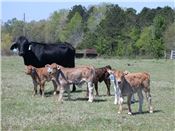Now Is A Critical Time For Spring Calving Cows
LITTLE ROCK, ARK.
Less-than-normal rainfall means slower-growing fescue and some operations will be feeding hay longer this spring – a time when grass grazing is critical for spring-calving cows.
“In a normal year spring calving cows would be making a transition from hay to fresh growth cool season forage in many parts of Arkansas,” said Tom Troxel, associate head-Animal Science, for the University of Arkansas System Division of Agriculture.
“The spring forage provides quality nutrition for both cow and nursing calf,” he said. “Even if it starts to rain again, it will take time for the cool season forage to grow to the point it can be grazed, putting spring grazing four to six weeks behind.”
And it is dry in much of the state. According to the U.S. Drought Monitor, areas without any drought rating fell from 54.32 percent the week of Feb. 3 to just 15.52 percent the week of Feb. 10. (See: http://droughtmonitor.unl.edu/Home/StateDroughtMonitor.aspx?AR)
“If normal rainfall events do not occur, cool season forage such as fescue will be very slow in growing resulting in much longer hay feeding into the spring months,”
“The last time monthly rainfall amounts was above average was July 2014.”
“Remember, one rain event will not replace six months of reduced rainfall. It will take a number of rainfall events over a period of time to replace the 7.26 inches of rain that would’ve been the normal rainfall from August 2014 into January 2015,” he said.
Rainy spring complicates issues
The abundance of rain in spring 2014 meant cattle producers were unable to cut hay at the optimum time for quality.
“Therefore, hay quality may not be as high to support lactating cows,” Troxel said. “Spring calving cows reach their peak milk production at 60 days post-calving.
“If cows are not properly supplemented with energy body condition will decline,” he said. “Because of the energy deficiency diet, cattle have used their fat reserves to maintain body function thus reducing body condition. This condition becomes very critical as the cattle production cycle moves into the rebreeding period.”
Forage tests and cow pies
Cow in poor body condition produce less milk compared to cows in moderate body condition. Troxel said cow body condition will affect the weaning weights of the 2015 calf crop. In addition, cows in poor body condition take longer to rebreed with will affect the 2016 calf crop.
At this point in the year, many cattle producers are reaching the end of their hay supplies.
“Often times the hay at the end of the feeding period is of lesser quality than the hay fed earlier in the feeding period,” he said. “It also can be hay held over from previous year.”
Troxel recommends forage testing the hay.
“Once the protein and energy values of the hay are known, the proper supplement can be determine to balance the diet,” he said. “Contact your local county agent for more information on how to conduct a forage test. Monitoring body condition and using the old technique of watching the shape and size of cow pies can aid a cattle producer in making supplemental feeding decisions, but neither can replace a forage test.” ∆

Nutrition is important when spring-calving season comes around.
(U of Arkansas System Division of Agriculture photo)